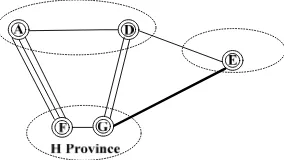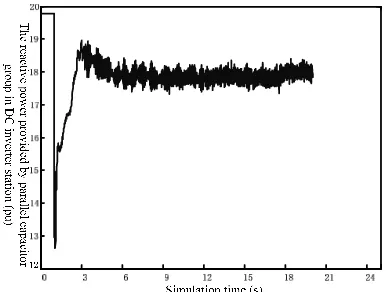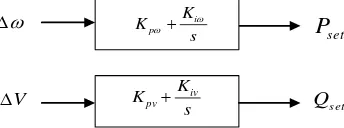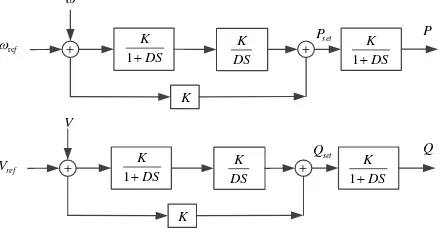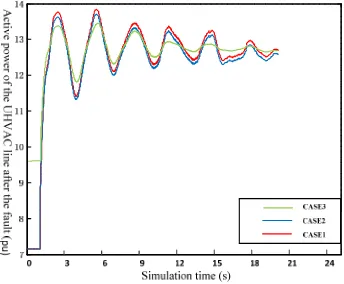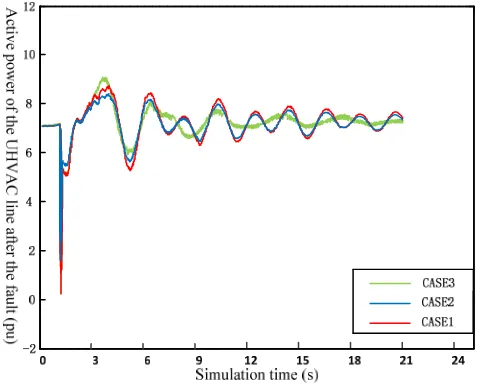DOI: 10.12928/TELKOMNIKA.v14i1.2372 423
Using STATCOM with Energy Storage to Enhance
AC-DC System Stability
Zheng Xu*1,2, Ding Jianyong1, Li Mei3, Zhao Shuang3, Zeng Ni3, Zhu Ruoxi3, Zhang Buhan3,Mao Chengxiong3
1School of Electrical Engineering Wuhan University. Wuhan, China 2
State Grid Hubei Economic Research Institute, Wuhan, China
3State Key Laboratory of Advanced Electromagnetic Engineering and Technology,
Huazhong University of Science and Technology, Wuhan, China *Corresponding author, e-mail: [email protected], [email protected],
Abstract
UHVDC has been rapidly developed for its large conveying capacity, small net loss and easy power control, which can solve the problem of the uneven distribution of load and energy with great economy. However, with DC transmission access, the power system must have a strong ability of reactive power support to cope with the possibility of transient voltage problem. At the same time, regional power oscillation issue also can’t be ignored. Considering that the STATCOM device, as a type of parallel FACTS, can only provide dynamic reactive power to support the system voltage and cannot undertake active regulation and control to damp system power oscillation problem, STATCOM with energy storage is presented in this paper to solve both problem of transient voltage and power oscillation in AC-DC hybrid system. In view of the central China province power grid planning, possible serious faults of the system were analyzed. The simulation results show that STATCOM with energy storage cannot only effectively support the system transient voltage and promote voltage of dc inverter station to avoid DC block caused by commutation failure, but also can significantly enhance the system damping and restrain regional power oscillation in case of system failure.
Keywords: STATCOM with energy storage, AC-DC hybrid system, voltage stability, power oscillation
Copyright © 2016 Universitas Ahmad Dahlan. All rights reserved.
1. Introduction
With the construction of UHVDC project, many areas have formed AC-DC hybrid transmission structure [1-2]. Regional interconnection of power grid can enhance economic operation, but it is easy to form weak links between groups of tightly coupled generations. On the other hand, quick response excitation system has been widely used in order to improve the transient stability of power grid. These factors will lead to insufficient damping of the interconnected system and increase the risk of regional power oscillation [3-4]. At the same time, Access of DC transmission put forward higher requirements in voltage supporting ability to the AC system. When there is an AC system fault, if not cleared immediately, it will make the DC converter voltage constantly low and cause a long time of commutation failure, which may cause DC block, thus affecting the stability of the interconnected system [5]. According to the plan, China H province gradually form AC-DC hybrid power grid. Through the simulation, voltage stability and low-frequency oscillations will be the severe problems that impact security operation of receiver grid in the AC-DC hybrid system.
studied the FACTS devices function to the promotion of system transient stability from two aspects: transmission capacity and level of voltage recovery after faults. However, the ability of FACTS for power oscillation damping is limited because it can’t conduct active power control. Combining energy storage and FACTS can realize those two functions. Paper [14] built a simulation model for the parallel FACTS with energy storage, and proved that it can suppress the swing of generator angle and improve the stability of power system. While the role of this device in improving voltage transient stability of AC system near inverter side and damping power oscillation remains to be further argument in the AC-DC hybrid system.
This article in view of potential stability problems in the planning AC-DC hybrid system of central China province, STATCOM with energy storage was studied to enhance the stability. The paper is organized as follows. In section 2, the instability of AC-DC system is described. In section 3 and 4, control principle and modeling of statcom with energy storage are presented. Section 5 gives the divice function through simulation. Section 6 concludes this paper.
2. The Instability of AC-DC System
According to the plan, China will gradually form AC-DC hybrid power grid [15]. Through the simulation of central China H province planning grid, voltage stability and low-frequency oscillations were the severe problems that impact security operation of receiver grid in the AC-DC hybrid system.
As shown in Figure 1, there are five UHVAC line and one parallel UHVDC line in the transmission section after UHVDC line EG accessed to H provinces. The transmission power of UHVAC lines is 10000 MW and UHVDC transmission capacity is 5000MW.
Figure 1. Diagram of H province with UHVDC and UHVAC connection
500kV M station near the UHVDC inverter is found to be the weakness point of H province power grid through to N-1 and N-2 fault scan. There are two lines between M and N station using the same tower. When the most severe three-phase permanent short-circuit fault occurs, those two lines will be removed from the system. M station voltage and UHVAC link power are shown in Figure 2 and Figure 3.
Voltage instability phenomenon occurs in M site and the voltage only restores to about 0.8pu after the fault cleared. At the same time, fault of M-N line inspires a long time power oscillation in UHVAC transmission line, with frequency of 0.5Hz, damping ratio of 3.23% and maximum oscillation amplitude of 336MW.
Here are the reasons why voltage instability occurs in M station. DC inverter station consumes a lot of reactive power during normal operation, reaching about 40% of the rated DC transmission capacity. When the receiver system line M-N fault is cleared, the inverter station requires a sharp increase in reactive power in the recovery process (about 1.5 times of the normal requirement), but at the same time, the voltage of the inverter station is not fully recovered, and only about 90 percent of reactive power is provided by shunt capacitors, as shown in Figure 4 and Figure 5. Thus, there appears severe reactive power deficiency near UHVDC inverter station, which further exacerbates the fault, and transient voltage instability occurs in receiver system.
Figure 4. Reactive power required by the inverter station
Figure 5. Reactive power provided by parallel capacitor group in DC inverter station
3. Control Principle of STATCOM with Energy Storage
The commonly used methods to improve the system stability are installation of parallel capacitor or reactor, PSS and STATCOM[16], their function comparisons shown in Table 1. Table 1 shows that parallel capacitor or reactor and STATCOM devices can enhance the voltage stability but their effects in power oscillation suppression are not obvious; PSS can damp power oscillation, but need to consider coordination control between numerous units and not apply to all oscillator modes. STATCOM with energy storage have independent control of active and reactive power, which can play a role in improving the AC-DC hybrid system transient voltage stability and power oscillation damping at the same time.
Table 1. The comparison table of commonly used devices to enhance system stability Methods Effect of improving voltage stability Power oscillation damping
Parallel capacitor or reactor modest none
STATCOM good poor
PSS none a certain range of oscillation frequency, but not apply to all oscillation modes
STATCOM with energy storage can provide or absorb power from the system, using electronics or other type controllers to independently adjust active and reactive power. These energy storage devices include battery, flywheel, superconducting magnetic energy storage, power storage capacitor and power springs, etc., [17].
power system stable controller) and inner loop controller( also called power regulator). Outer loop controller is the master controller device, which can send active and reactive power reference value to the inner loop controller according to the system demand; inner loop controller will calculate magnitude and phase of converter output voltage according to the outer controller reference value, and then generate switch trigger signals for converts. Therefore, it can conduct active and reactive power quadrant adjustment in real time through a closed loop feedback control by measuring the voltage, current or other power system parameters [18]. Control structure of STATCOM with energy storage is shown in Figure 6.
P
Q
Figure 6. Control of STATCOM with energy storage
4. Modeling of STATCOM with Energy Storage
Power system stability controller usually adopts PI closed loop control. The system frequency is mainly related to active power, and the voltage is mainly related to reactive power. Therefore, active and reactive power reference values can be respectively calculated according to the deviation of frequency and voltage signal. Its structure is shown in Figure 7.
Figure 7. Power system stability controller of STATCOM with energy storage
The power regulator can be described by using first-order inertia model [19]:
1 1
Where, T is the time constant, usually range from 0.02s to 0.05s. P, Q is the output active and reactive power of inner controller. Pset, Qset is output reference value of the outer loop controller.
ref ref
P Q
P Q
Figure 8. Transient simulation flow-process of STATCOM with energy storage
1
Figure 9. Transient model of STATCOM with energy storage
5. The Simulation of AC-DC Hybrid System Stability
Build the model of STATCOM with energy storage and connect it to the 220kV bus of weak station (M site) in H province power grid. M station has two three-phase transformers with rated power of 1000MW. The device storage capacity is set to 3000MJ, and the capacity of power electronic converters is 600MVA, accounting for 30% of the transformer capacity. When DC or receiver AC system failure occurs, the simulation results were observed and recorded under several different devices installed near DC inverter station.
Mark the scene of none device installation for CASE1, and the scene of installation with STATCOM for CASE2 and STATCOM with energy storage for CASE3. Main generators that participate in the regional oscillation of AC-DC interconnected system are equipped with the power system stabilizer(PSS).
5.1. DC Fault Simulation
DC line fault occurs at 1s, and DC line will be lockout at 1.1s. The voltage of main site in H province is given in Figure 10 and the UHVAC line power oscillation is shown Figure 11. From Figure 10, we can see that after the HVDC line bipolar blocking, the system have large power shortage, and the voltage of UHVAC lines and receiver system remains low in CASE1. CASE2 and CASE3 show that after installing STATCOM or STATCOM with energy storage, main sites voltage of H province is improved in DC bipolar blocking conditions. In CASE3, voltage promotion of UHVDC line 1000kV access site reaches 6.23% and 500kV access site reaches 8.52%. Its voltage supporting effect is better than the CASE2( respectively 5.16% and 7.36%), this is because STATCOM with energy storage can provide active and reactive power required by the system. The balance of active power will indirectly affect the system voltage.
(a) Bus voltage of UHVDC access sites (b) Bus voltage of other important sites
Figure 10. Main bus voltage of H province’s power grid after the DC fault
Figure 11. Power oscillation of UHVAC line after the DC fault
5.2. AC Fault Simulation
From the above analysis we know that 500kV M station and M-N line is the weak link of H province. Set M-N line N-2 fault as follows: one single line three-phase short circuit fault occurs at 1s and then two lines are cut out at 1.1s. The voltage fluctuations after the failure are shown in Figure 12, and UHVAC line power oscillation is shown in Figure 13.
(a) Bus voltage of UHVDC access sites (b) Bus voltage of other important sites
Seen from Figure 12, CASE1 is the most serious condition at voltage dip, with M station voltage only recovered to 0.8 p.u. after the fault cleared. CASE2 and CASE3 show that after mounting STATCOM or STATCOM with energy storage, M station voltage can be recovered to normal value after failure. The placement of those devices plays an important role in supporting DC inverter voltage and improving the running stability of the DC system.
Figure 13. Power oscillation of UHVAC line as the three permanent fault occurred in M-N line
The maximum power oscillation amplitude in CASE1 is 336MW and the damping ratio is 3.23% (weak damp status), as shown in Figure 13. And in CASE2 they are 330MW and 3.28%, indicating that STATCOM is ineffective in power oscillation suppression. However, in CASE3, the installation of STATCOM with energy storage can obviously suppress UHVAC lines power oscillation, with damping ratio increased to 9.87%.
6. Conclusion
This paper proposes the method of using STATCOM with energy storage to solve the voltage stability and regional power oscillation problems caused by the system faults. Its modelling is presented. And its function is analyzed under the conditions of UHVDC blocking fault and receiver AC system three-phase circuit short through simulation. The results show that STATCOM with energy storage can enhance the DC hybrid system transient voltage stability and effectively suppress UHVAC lines power oscillation, which has a significant role in realizing multi-objective stability control and improving operation security in AC-DC hybrid system.
References
[1] Yogendra Arya, Naredra Kumar, Hitesh Dutt Mathur. Automatic Generation Control in Multi Area Interconnected Power System by using HVDC Links. International Journal of Power Electronics and Drive System (IJPEDS). 2012; 2(1): 67-75.
[2] Wang Juanjuan, Zhang Yao, XIA Chengjun, et al. Survey of Studies on Transient Voltage Stability of AC/DC Power System. Power System Technology, 2008; 32(12): 30-34.
[3] Zhu Fang, ZHAO Hongguang, Liu Zenghuang. The Influence of Large Power Grid Interconnected on Power System Dynamic Stability. Chinese CSEE. 2007; 27(1): 1-7.
[4] D Narasimha Rao, V Saritha. Power System Oscillation Damping Using New Facts Device.
International Journal of Electrical and Computer Engineering (IJECE). 2015; 5(2): 198-204.
[6] Qi Xu, Zeng Dewen, Shi Dajun, Fang Xiaosong, Li Lan, Su Hongtian, Wu Wei. Study on Impacts of UHVDC Transmission on Power System Stability. Power System Technology. 2006; 30(2): 1-6. [7] M Zakir Hossain, Md Kamal Hossain, Md Alamgir Hossain, Md Maidul Islam. Performance Analysis of
a High Voltage DC (HVDC) Transmission System under Steady State and Faulted Conditions.
TELKOMNIKA Indonesian Journal of Electrical Engineering. 2014; 12(8): 5854-5860.
[8] Ding Lijie, Du Xinwei, Zhou Wei Jing. Comparison of application of SVC and STATCOM to large capacity transmission path of power system. Power System Protection and Control. 2010; 38(24): 77-87.
[9] Li Dan. Research on Impact of STATCOM on Operation Performances of HVDC. Disertation. North China Electric Power University: 2014.
[10] Guo Chunyi, Zhang Yanpo, Zhao Chengyong, Ni Junqiang, Zhang Yi. Impact of STATCOM on the Operating Characteristics of Double-infeed HVDC System. Chinese CSEE. 2013; 33(25): 99-106. [11] Li Haichen. Research on Analysis of Interaction between FACTS and HVDC System and Control
Strategy. Disertation. South China University of Technology: 2012.
[12] Hu Yanmei. Analysis of Static Voltage Stability Characteristics and Optimal Allocation of FACTS for AC/DC Hybrid Power System. Disertation. Beijing Jiaotong University: 2014.
[13] Zuo Yuxi, Wang Yating, Xing Lin, Shen Hong, Zheng Bin, Li Jing, Ban Liangeng, Zhou Qinyong, Li Runqiu, Zheng Nan, Fan Keqiang. Applied Research on New Types of High Capacity FACTS Devices in Northwest 750 kV Power Grid. Power System Technology. 2013; 37(8): 2349-2354. [14] Zhang Buhan, Ma Zhiquan, Xie Guanglong, Zeng Jie, Li Xiaoping, Mao Chengxiong, Cheng Shijie.
Modelling and Simulation of Parallel FACTS with Energy Storage in Power System Analysis Software Package. Power System Technology. 2010; 34(3): 31-36.
[15] Xu Zheng. Dynamic behavior of AC and DC power system analysis. Second Edition. Beijing: Mechanical Industry Press. 2004.
[16] Han-Ki K.Dynamic coordination strategies between HVDC and STATCOM. Asia and Pacific Transmission & Distribution Conference & Exposition. Seoul, IEEE Power & Energy Society. 2009: 1-9.
[17] Cheng Ming, Wang Qingsong, Zhang Jianzhong. Theoretical Analysis and Controller Design of Electric Springs. Chinese CSEE. 2015; 35(10): 2436-2444.
[18] Yao Tao. The Study on the Control of Superconducting Magnetic Energy Storage. Disertation. Huazhong University of Science and Technology and Strategy: 2006.
